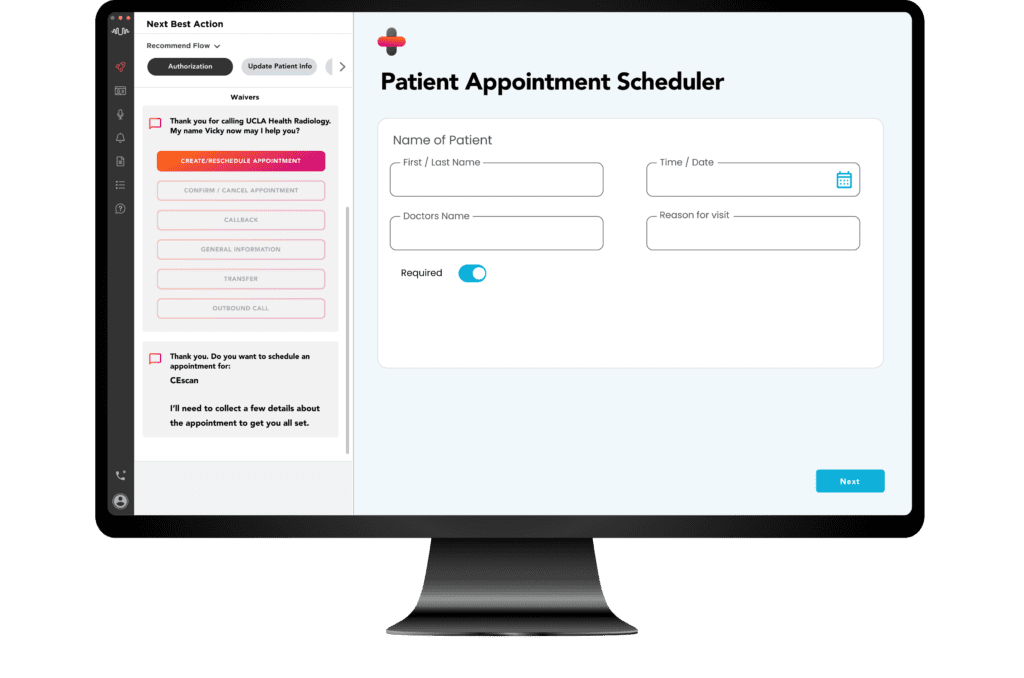Call center KPIs and agent performance metrics are critical tools for gauging agents’ productivity and revealing areas for improvement with AI and automation.
How is call center efficiency measured?
Call center metrics and KPIs (key performance indicators) are the primary methods for measuring a call center’s efficiency and performance. These indicators gauge the health of key areas within a call center’s operations—from overall customer satisfaction to individual call center agent performance. They are also used to identify areas for improvement, both on the business (macro) level and agent (micro) level. For example, if a healthcare provider has a long average handle time (AHT)—a key call center KPI—it could indicate a bottleneck in how its agents process patient information.
Call center KPI data can come from a variety of sources. Customer satisfaction surveys, for instance, provide valuable data on how customers perceive the service they receive. Other data comes from call diagnostics, like AHT and average wait time. Often, one KPI may impact another, such as long wait times dragging down customer satisfaction scores. That’s why accurate KPI analysis is vital for understanding call center metrics—and why more contact centers are turning to AI and automation for the data-rich insights they need to optimize their operations.

Most important call center metrics and KPIs
The most important call center performance metrics are the ones that impact customer lifetime value and, consequently, revenue. Customer lifetime value (CLV) is the total revenue a customer is expected to generate during the lifetime of their relationship with a business. From a call center perspective, the factors that impact CLV are, unsurprisingly, tied to customer experience: convenience and ease, understanding and empathy, and consideration for customers’ time and patience. Call center KPIs that measure these factors include:
Customer service KPIs
Customer service KPIs measure how well a contact center performs as a whole. These metrics look at center-wide averages across a range of indicators:
Customer satisfaction score
Customer satisfaction (CSAT) is a measure of how happy customers are with a company, its products and/or services. Contact centers often rely on customer satisfaction (i.e. Voice of the Customer) surveys and other feedback methods to gauge their CSAT level. CSAT provides a benchmark for how a company’s offerings and customer service meet, exceed or fall short of customer expectations.
Call abandonment rate
Call abandonment rate is the percentage of total inbound customer service calls in which the customers hang up before engaging with a live customer service agent. Abandonment rate is influenced by factors such as the speed in which the customer is connected to a live agent and the degree to which a customer is dissatisfied with the product or service they’ve called in for.
Average wait time
Average wait time (AWT), also known as average speed of answer (ASA), refers to the duration an inbound caller spends in the queue. The industry standard AWT is 80% of calls answered within 20 seconds. Reducing the time callers spend waiting to interact with your agents can lower your call abandonment rate and improve overall customer satisfaction.
Peak hour traffic
Peak hour traffic (PHT) gauges a contact center’s performance during the times of the day when call volume is the highest. PHT is a key call center KPI for ensuring enough staff is available to handle daily call spikes. AI and automation can also help PHT by deflecting low-value calls to self-service and assisting agents during complex live interactions.
Agent productivity KPIs
Agent productivity KPIs, also called agent performance metrics, measure how individual contact center agents perform in several key areas, including (but not limited to):
First contact resolution
First contact resolution (FCR), also known as first call resolution, refers to a call center resolving an issue for a customer on the first call. Factors that impact FCR include the complexity of the customer request, agent access to relevant information and knowledge of appropriate next-best actions. Contact centers with high FCR rates see higher customer satisfaction (CSAT) scores and lower customer churn.
First response time
First response time (FRT) is a call center KPI that measures how long it takes an individual agent to respond to a customer once they’ve entered the call queue. A high FRT is often a symptom of problematic process: too many manual administrative tasks, a cumbersome knowledge management system and/or excessive aftercall work.
Average handle time
An agent’s average handle time (AHT) is the average amount of time it takes for a call to be completed. AHT consists of the duration of the call, from the moment an agent picks up the call to the final tone. This time is spent discovering what customers need, performing any requisite on-call tasks and resolving or answering their query. Agents often must balance reducing average handle time and ensuring customers feel listened to and supported for the entirety of their call.
Average call transfer rate
Average call transfer rate (or just transfer rate) is the mean number of calls an agent ends up transferring to another agent or department. Because transfers prolong a call (and may require customers to repeat information to multiple parties), high call transfer rates can negatively impact customer satisfaction.
Financial (business) KPIs
In addition to call center performance metrics, customer service providers rely on financial KPIs to gauge their bottom-line health. Examples of financial (business) KPIs include:
Cost per contact
Cost per contact is the average cost a contact center incurs to handle a single call. To calculate cost per contact, divide your total cost (OpEx + CapEx) by the number of contacts your call center handles (calls handled – calls abandoned) during a given time (i.e. week, month, year). According to CX Today, anywhere between $2.70 and $5.60 is an acceptable cost per call, including “direct labor, indirect labor, and operational expenses.”
Service level agreement
A service level agreement (SLA) is a written contract between a contact center and its client(s) that establishes the center’s customer service standards. SLAs often stipulate call center KPI expectations and acceptable performance metrics. A healthcare provider, for example, may expect a contact center to answer 80 percent of patient calls within 20 seconds.
Agent attrition rate
Agent attrition rate represents the average percent of call center agents who turnover during a given period. Call centers have historically struggled with high attrition, with estimates often hovering between 30 and 40 percent. Increasing call complexity, insufficient training and coaching, outdated tools and workplace stress are among the leading causes of agent attrition.
Agent utilization rate
Call center agent utilization rate is the ratio of agents’ productivity (time spent answering calls, performing call-related work, etc.) divided by their capacity. This call center KPI is valuable for assessing whether agents are being utilized to their full potential. Like other agent performance metrics, a poor utilization rate may indicate process inefficiencies or obstacles.
Call volume trends
Call volume trends offer valuable data about the type and frequency of inbound calls a contact center receives. Contact centers can use call volume trends to determine when and where additional support and/or tools—such as conversational AI and automation—could improve agent performance, operational efficiency and customer experience.
Case Study: Leading US Health Insurance Brand Increases Agent Productivity with Automation


Challenges and
business needs
The company had limited agent bandwidth and had to deal with high call volumes. It was observed that manual after-call-work summarization caused factual errors and agents sometimes missed out on capturing important information. Additionally, it was difficult to monitor every call manually to capture important information accurately from the customers’ voice data.
This task used to take about 60 seconds for each call, taking the average call handling time to five minutes. It was observed that call center agents were spending too much of their valuable time in mandatory aftercall work tasks. The company wanted to automate this process to help agents reduce the time spent doing mandatory tasks, increase their productivity and bring more focus on client servicing.
Key Challenges
- Agents spending valuable time on aftercall work
- Agents not able to truly listen to voice of customer
- Agents distracted by having to access multiple applications
- Agents not able to derive insights due to huge call volumes
Solution
The customer chose U-Assist, Uniphore’s agent co-pilot solution, to reduce the operational cost and time spent by customer service advisors on mandatory tasks. U-Assist uses the power of conversational service automation—a combination of AI, natural language processing (NLP) and machine learning (ML) technologies—to increase the productivity of contact center agents by automating disposition capture and aftercall work summarization of every call.


How conversational
service automation works
As the call progresses between a customer and the agent, the solution transfers the recorded audio to the transcription engine where the speech is converted to text. The transcript of the call is further sent to an NLP layer to extract relevant information. The system then automatically generates the call summary. The auto-summarized report of a call eventually reflects on the agent desktop application, where the agent can review and edit the call summary and take necessary action(s) if required. (You can read more about how U-Assist works and its business benefits here.)
Benefits
The health insurer began reaping the benefits of conversational automation soon after deploying U-Assist. By augmenting the capabilities of its existing agents with AI and automation, it was able to reduce aftercall work by 80 percent, cut AHT by 20 percent and increase its FCR rate significantly. This increase in agent productivity not only improved customer satisfaction—it also directly contributed to roughly $6 million in annual cost savings.
Summary
Call center metrics and KPIs are vital to the ongoing health, viability and market competitiveness of any contact center. Call center KPIs not only identify performance roadblocks and process inefficiencies; they also assess how effective a given solution is at correcting those shortcomings. In the case of the health insurer above, high AHT and call volume trends indicated that its agents were struggling with two parts of the process: in-call application overload and excessive aftercall work. By unifying its agents’ desktops and automating notetaking and call summarization the insurer was able to eliminate these (and other) friction points and drive hyper-efficiency—as indicated by its post-solution metrics.
